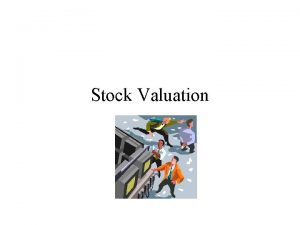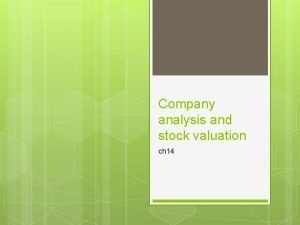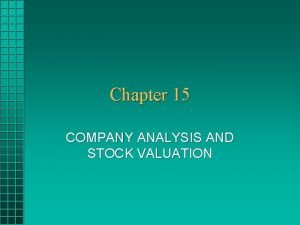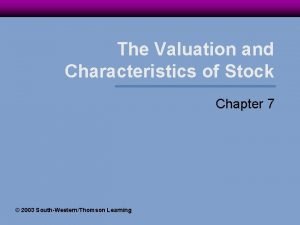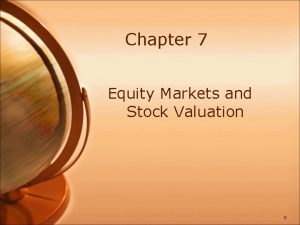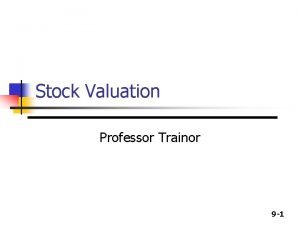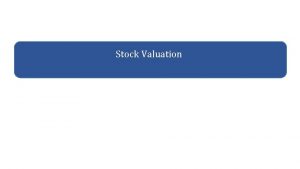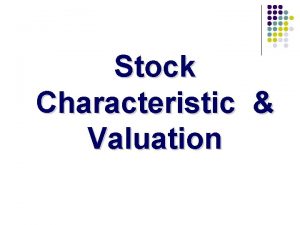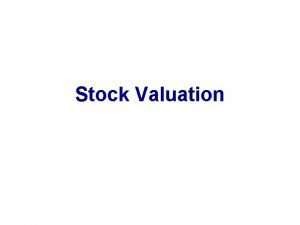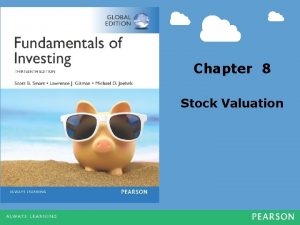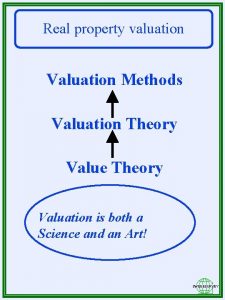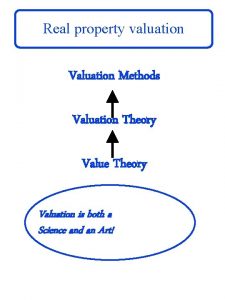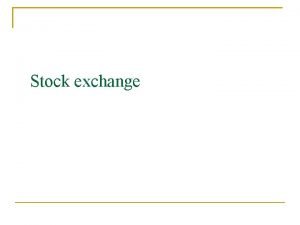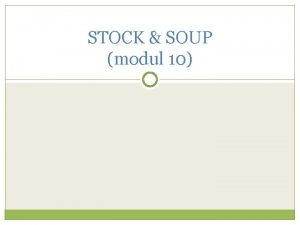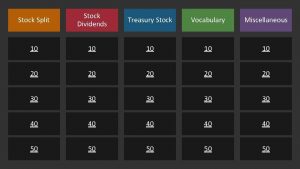Stock Valuation One Period Valuation Model To value




















- Slides: 20

Stock Valuation

One Period Valuation Model • To value a stock, you first find the present discounted value of the expected cash flows. • P 0 = Div 1/(1 + ke) + P 1/(1 + ke) where – P 0 = the current price of the stock – Div = the dividend paid at the end of year 1 – ke = required return on equity investments – P 1 = the price at the end of period one

One Period Valuation Model • P 0 = Div 1/(1 + ke) + P 1/(1 + ke) – Let ke = 0. 12, Div = 0. 16, and P 1 = $60. • P 0 = 0. 16/1. 12 + $60/1. 12 • P 0 = $0. 14285 + $53. 57 • P 0 = $53. 71 – If the stock was selling for $53. 71 or less, you would purchase it based on this analysis.

Generalized Dividend Valuation Model • The one period model can be extended to any number of periods. – P 0 = D 1/(1+ke)1 + D 2/(1+ke)2 +…+ Dn/(1+ke)n + Pn/(1+ke)n • If Pn is far in the future, it will not affect P 0 • Therefore, the model can be rewritten as: – ∞ t P 0 = S D /(1 + k ) t e t=1

Generalized Dividend Valuation Model • The model says that the price of a stock is determined only by the present value of the dividends. – If a stock does not currently pay dividends, it is assumed that it will someday after the rapid growth phase of its life cycle is over. • Computing the present value of an infinite stream of dividends can be difficult. • Simplified models have been developed to make the calculations easier.

The Gordon Growth Model Some firms try to increase their dividends at a constant rate. P 0 = D 0(1+g)1 + D 0(1+g)2 +…. . + D 0(1+g)∞ (1+ke)1 (1+ke)2 (1+ke)∞ D 0 = the most recent dividend paid g = the expected growth rate in dividends ke = the required return on equity investments The model can be simplified algebraically to read: P 0 = D 0(1 + g) D 1 = (ke - g) (ke – g)

Gordon Growth Model • Assumptions: – Dividends continue to grow at a constant rate for an extended period of time. – The growth rate is assumed to be less than the required return on equity, ke. • Gordon demonstrated that if this were not so, in the long run the firm would grow impossibly large.

Gordon Model: Example • Find the current price of Coca Cola stock assuming dividends grow at a constant rate of 10. 95%, D 0 = $1. 00, and ke is 13%. – P 0 = D 0(1 + g)/ke – g – P 0 = $1. 00(1. 1095)/0. 13 - 0. 1095 = – P 0 = $1. 1095/0. 0205 = $54. 12

Gordon Model: Conclusions • Theoretically, the best method of stock valuation is the dividend valuation approach. • But, if a firm is not paying dividends or has an erratic growth rate, the approach will not work. • Consequently, other methods are required.

Price Earnings Valuation Method • The price earning ratio (PE) is a widely watched measure of how much the market is willing to pay for $1 of earnings from a firm. • A high PE has two interpretations: – A higher than average PE may mean that the market expects earnings to rise in the future. – A high PE may indicate that the market thinks the firm’s earnings are very low risk and is therefore willing to pay a premium for them.

Price Earnings Valuation Method • The PE ratio can be used to estimate the value of a firm’s stock. • Firms in the same industry are expected to have similar PE ratios in the long run. • The value of a firm’s stock can be found by multiplying the average industry PE times the expected earnings per share. P/E x E = P

Price Earnings Model: Example • The average industry PE ratio for restaurants similar to Applebee’s is 23. What is the current price of Applebee’s if earnings per share projected to be $1. 13? – P 0 = P/E x E – P 0 + 23 x $1. 13 = $26.

Price Earnings Valuation Method • Advantages: – Useful for valuing privately held firms and firms that do not pay dividends. • Disadvantages: – By using an industry average PE ratio, firmspecific factors that might contribute to a longterm PE ratio above or below the average are ignored.

Setting Security Prices • Stock prices are set by the buyer willing to pay the highest price. – The price is not necessarily the highest price that the stock could get, but it is incrementally greater than what any other buyer is willing to pay. • The market price is set by the buyer who can take best advantage of the asset.

Setting Security Prices • Superior information about an asset can increase its value by reducing its risk. – The buyer who has the best information about future cash flows will discount them at a lower interest rate than a buyer who is uncertain.

Errors in Valuation • Problems with Estimating Growth – Growth can be estimated by computing historical growth rates in dividends, sales, or net profits. – But, this approach fails to consider any changes in the firm or economy that may affect the growth rate. • Competition, for example, will prevent high growth firms from being able to maintain their historical growth rate. • Nevertheless, stock prices of historically high growth firms tend to reflect a continuation of the high growth rate. • As a result, investors receive lower returns than they would by investing in mature firms.

Estimating Growth: Table 1 Stock Prices for a Security with D 0 = $2. 00, ke = 15%, and Constant Growth Rates as Listed Growth(%) 1 3 5 10 11 12 13 14 Price $14. 43 17. 17 21. 00 44. 00 55. 50 74. 67 113. 00 228. 00

Errors in Valuation • Problems with Estimating Risk – The dividend valuation model requires the analyst to estimate the required return for the firms equity. – However, a share of stock offering a $2 dividend a 5% growth rate changes with different estimates of the required return.

Estimating Risk: Table 2 Stock Prices for a Security with D 0 = $2. 00, g = 5%, and Required Returns as Listed Required Return(%) 10 11 12 13 14 15 Price $42. 00 35. 00 30. 00 26. 25 23. 33 21. 00

Errors in Valuation • Problems with Forecasting Dividends – Many factors can influence the dividend payout ratio. They include: • The firm’s future growth opportunities a • Management’s concern over future cash flows • Conclusion: – Analysts are seldom certain that the stock price projections are accurate. – This is why stock prices fluctuate widely on news reports.
 In the one period valuation model
In the one period valuation model Valuation of fixed income securities or valuation of bonds
Valuation of fixed income securities or valuation of bonds Contoh value creation
Contoh value creation Company analysis and stock valuation
Company analysis and stock valuation Avco method of stock valuation
Avco method of stock valuation Company analysis stock valuation
Company analysis stock valuation Characteristics of stock valuation
Characteristics of stock valuation Grade 12 accounting inventory valuation
Grade 12 accounting inventory valuation Equity markets and stock valuation
Equity markets and stock valuation Common stock valuation
Common stock valuation Preferred stock valuation
Preferred stock valuation Long-term debt preferred stock and common stock
Long-term debt preferred stock and common stock Kriteria standar white stock yang baik adalah
Kriteria standar white stock yang baik adalah Characteristics of common shares
Characteristics of common shares Stock initial - stock final
Stock initial - stock final Introduction to valuation the time value of money
Introduction to valuation the time value of money One god one empire one emperor
One god one empire one emperor One one one little dog run
One one one little dog run One king one law one faith
One king one law one faith One god one empire one emperor
One god one empire one emperor One ford plan
One ford plan
